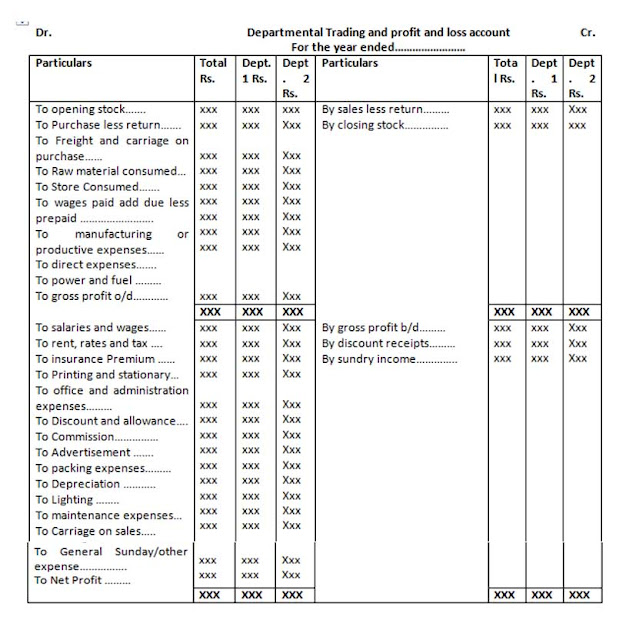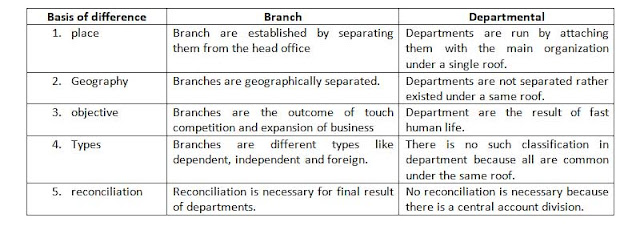Accounting for
department of Activity
Concept
Today's modern life is very
mechanical and complex especially in big cities. In this situation, the
resident of such cities expects expect all the goods and services under a
single roof. The departmental stores are the example of large scale retail
selling just under a single roof. Different departments are involved for
different goods to be sold out. In other words, when business grows and sells
various kinds of goods or provides variety of activities under the same rood,
it needs to be split up into a number of departments. These departmentsgenerally found in business of almost all size. A department is usually, a unit
of the rest of the business and functions as a physical part of it. Each
department is considered a separate profit center though, geographically, each
department is an integral part of the rest of the departments.
To calculate the net result
of the whole organization, a full fledgling trading and profit and loss account
is to be prepared. But to evaluate individual department, it will be credit
worthy to prepare individual trading and profit and loss account. Such individual accounts will help to evaluate individual department, then such
accounting system is termed as department accounting.
Objectives of accounting for department of activity
Department accounting system
is used to calculate operating results i.e., profit or loss of individual
department as well as the net result of the whole organization. The main
objectives of departmental accounting are:
- To record income and expenditure of each department.
- To find out profit or loss of each department.
- To checkout interdepartmental performance on the basis of trading results.
- To evaluate the performance of the department with previous period result.
- To assist the management for making decision to drop an existing department or add a new department
- To assist management for cost control.
Difference between Branch and Department
Following are the main differences
in between branch and department:
Types of accounting Procedures of Departmental Accounting
Departmental accounting can
be prepared by using the following two methods:
- Separate unit method
- Analytical method
Analytical method: this method is known as columnar basis method. Under this method, each account constrains individual column for each department. Similarly, various subsidiary books are prepared containing individual column for each department and such subsidiary books make easy to prepare departmental trading and profit and loss account. In other words, under this method, it is convenient to prepare departmental trading and profit and loss account using columnar or analytical purchase day book and sales day book for recording credit purchase and credit sales of each department and so as other subsidiary books. This method is useful, if the numbers of departments are small.
Departmental Trading and profit and loss account
At the end of accounting
period, departmental trading and profit and loss account is prepared including
individual column for each department on it. Such departmental trading and
profit and loss account is prepared by using the following format:
Allocation of Common expenses
Expenses directly related to
a particular department can be charged directly to that department. For
example, salary of employees of a particular department or bad debts from the
sale of a particular department can be charged to the concerned department directly.
Similarly, the expenses which have a direct bearing with the sales should be
apportioned on the basis of net sales. For example, advertisement expense
should be apportioned on the basis of departmental sales to outside customers.
But there are some other common or joint indirect expense, which should be
apportioned on the most logical basis. The nature of the expenses and nature of
the business will determine the basis for apportionment of expenses. The bases
for apportionment of some important expenses are given below:
Inter-department Transfer
When a department supplies
goods to another department, then it is called inter-department transfer. Since
each department is considered as a separate profit center, it is necessary to
have separate records for inter-departmental transfer. Generally, the following
journal entry is made in the case of such transfer:
Supplying department shows
such inter-department transfer on credit side of its Trading account treating
them as sales. Similarly, receiving department treats such transfer as purchase
and is shown on debit side of its trading account.
Transfer price can be cost
based or market based. They are discussed below:
- Inter-departmental transfersat cost price
Under cost-based transfer
pricing, the price may be based on actual cost, total cost or standard cost.
Marginal cost is also sometimes used as a basis of ascertaining transfer price.
Standard cost is preferred to actual cost since the inefficiency of one
department cannot be passed on to another department. While transferring goods
at cost price, no adjusting entry is needed.
- Inter-departmental transfers at selling or market price
When goods are transferred
from one department to another at a price higher than its cost price, then it
is called inter-departmental transfer at selling price. The accounting
treatment of such inter-departmental transfer at selling price is exactly the
same as stated above in the case of cost price except with regard to stock at
the beginning and at the end of such transferred goods. The amount of profit
included on these opening and closing stock is called unrealized profit and that
must be adjusted by passing the following some additional adjusting entries.
Adjusting entry for unrealized profit included in closing stock:
Adjusting entry for unrealized profit included in opening stock:
Review of Theoretical concept
Explain inter department transfer.
When a department suppliers
goods to another department, then it is called inter-department transfer. Since
each department is considered as a separate profit center, it is necessary to
have separate records for inter-departmental transfer. Generally, the following
journal entry is made in the case of such transfer:
Supplying department shows
such inter-department transfer on credit side of its trading account treating
them as sales similarly, receiving department treats such transfer as purchase
and is shown on debit side of its trading account transfer price can be cost
based or market based.
Difference between branch and department.
Following are the main
difference in between branch and department:
















It was a very good post indeed. I thoroughly enjoyed reading it in my lunch time. Will surely come and visit this blog more often. Thanks for sharing.
ReplyDeleteAccounting services in Houston
Accounting firm in Chicago
Hybrid Accounting sitemap
CPA firm in Dallas
Accounting firm in Austin
Tax Preparation Services in Fort Worth
our enthusiasm leads you beyond the limits. When you feel yourself enthusiastic that’s the time you can cross any limit. You seek to get perfection by using the ability of work. Read such motivational article and definitely it will help you to know new facts. assetz
ReplyDelete